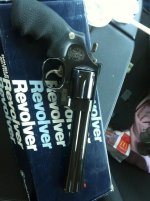Waddy
US Veteran
I recently acquired a very nice Mod 629-4, 6 1/2" barrel, Ser. CBR3###. It has "Smith & Wesson" printed on the left side of the barrel with what looks like laser lettering, and "44 Magnum" on the left side of the barrel lug. It has "629 Classic DX" on the right side of the barrel in the same type lettering. It has an interchangeable front site with 4 extra sight blades. It was purchased new in July, 1997.
Would someone be kind enough to enlighten me on the significance of the "Classic DX" designation. Also, if there is a place on this forum (or elsewhere) that I should have looked, I would appreciate that information also. Thanks in advance.
Would someone be kind enough to enlighten me on the significance of the "Classic DX" designation. Also, if there is a place on this forum (or elsewhere) that I should have looked, I would appreciate that information also. Thanks in advance.




